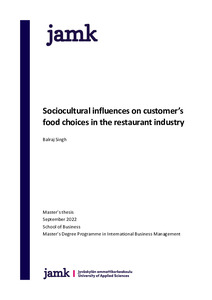Sociocultural influences on customer’s food choices in the restaurant industry
Singh, Balraj (2022)
Singh, Balraj
2022
All rights reserved. This publication is copyrighted. You may download, display and print it for Your own personal use. Commercial use is prohibited.
Julkaisun pysyvä osoite on
https://urn.fi/URN:NBN:fi:amk-2022092920581
https://urn.fi/URN:NBN:fi:amk-2022092920581
Tiivistelmä
Introduction:
This thesis aims to study the impact of socio-cultural factors on customers’ food choices in case of res-taurant industry. The study also explores the different food choices challenges that the restaurant industry face. The following study questions guide the research: What are the various socio-cultural factors and how do these factors impact on customers’ preferences in case of buying foods from res-taurants in Australia?
Methodology:
The study answers the questions using primary research. In particular, a total of 100 participants were sampled through the convenience method of sampling. Data collection was done through the survey method, utilizing questionnaires as the data collection tool. The data was analysed using inferential statistics including correlation and regression in SPSS to answer research questions.
Results:
Overall, the findings indicate a negative and moderate correlation between the kind of food restau-rant users prefer nationality, gender, and marital status. This implies that nationality, gender, and mar-ital status have an adverse impact on customers’ choices, but a little bit not too much. It also implies that people with a strong sense of nationality and family are less likely to have a positive preference about eating in restaurants. Conversely, there is a positive and weak correlation between food prefer-ences and income level and the same was for religious background. This means that different religious or social groups are directly affected by the factors like the price of food and the type of food they eat when they go out However, there is a need for further research to confirm these findings, considering the high significance scores. Nevertheless, the results help indicate that food preferences are an im-portant consideration for restaurants owner to consider when designing their menus depending on their target audience and locations.
This thesis aims to study the impact of socio-cultural factors on customers’ food choices in case of res-taurant industry. The study also explores the different food choices challenges that the restaurant industry face. The following study questions guide the research: What are the various socio-cultural factors and how do these factors impact on customers’ preferences in case of buying foods from res-taurants in Australia?
Methodology:
The study answers the questions using primary research. In particular, a total of 100 participants were sampled through the convenience method of sampling. Data collection was done through the survey method, utilizing questionnaires as the data collection tool. The data was analysed using inferential statistics including correlation and regression in SPSS to answer research questions.
Results:
Overall, the findings indicate a negative and moderate correlation between the kind of food restau-rant users prefer nationality, gender, and marital status. This implies that nationality, gender, and mar-ital status have an adverse impact on customers’ choices, but a little bit not too much. It also implies that people with a strong sense of nationality and family are less likely to have a positive preference about eating in restaurants. Conversely, there is a positive and weak correlation between food prefer-ences and income level and the same was for religious background. This means that different religious or social groups are directly affected by the factors like the price of food and the type of food they eat when they go out However, there is a need for further research to confirm these findings, considering the high significance scores. Nevertheless, the results help indicate that food preferences are an im-portant consideration for restaurants owner to consider when designing their menus depending on their target audience and locations.
